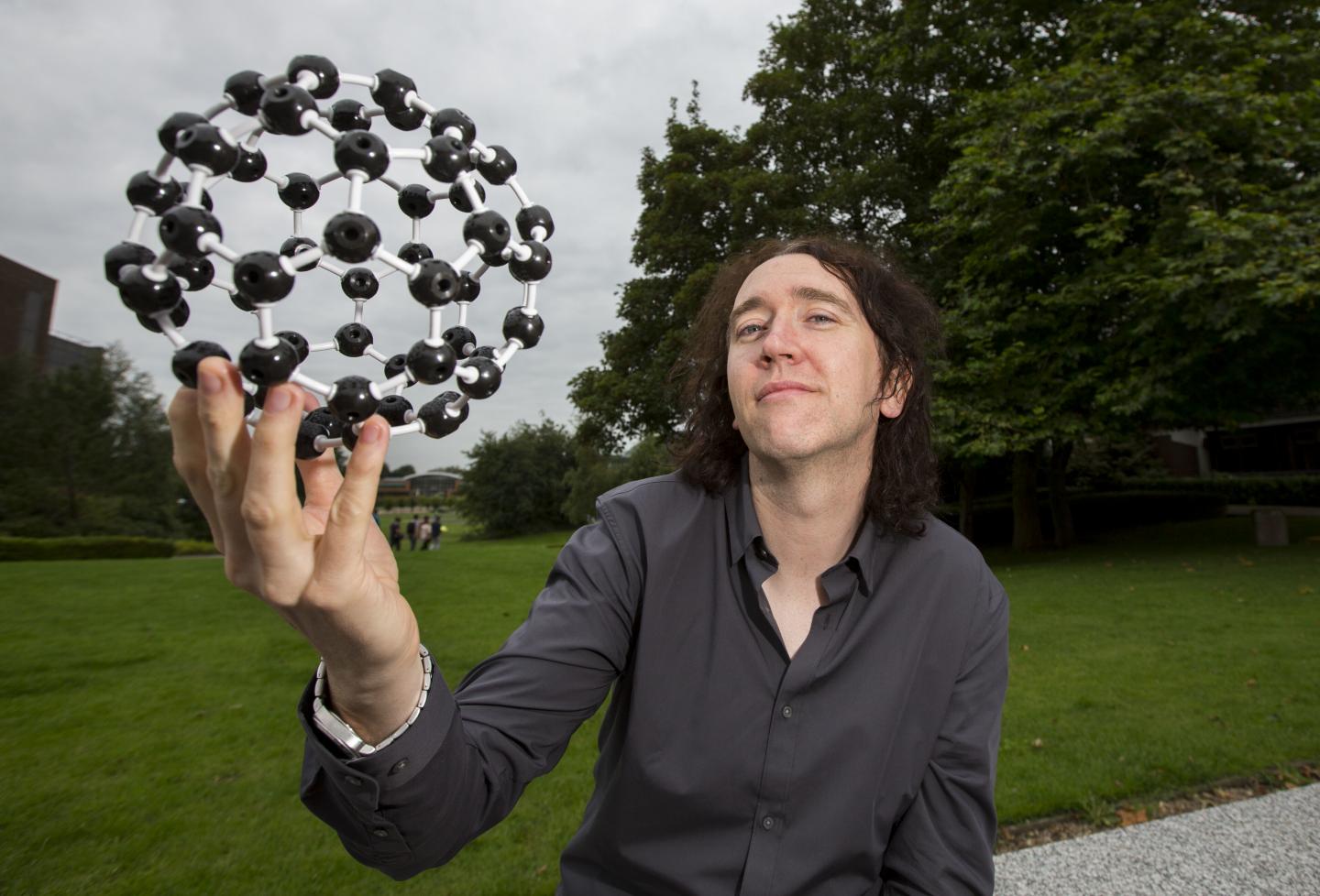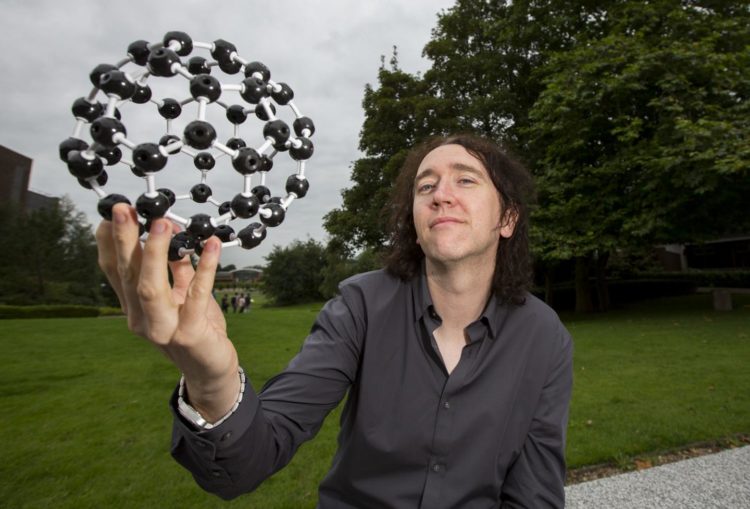Scientists at University of Limerick’s (Ireland) Bernal Institute have helped discover a molecule that could have a major impact on how data is stored and processed

Credit: Alan Place
Scientists at University of Limerick’s Bernal Institute have helped discover a molecule that could have a major impact on how data is stored and processed.
The UL researchers found that a simple metal-organic molecule can go beyond simple binary (0 – OFF, 1 – ON) computing logic and can in fact switch between three distinct, long-lived states.
This first demonstration of a ternary ‘molecular traffic light’ device could provide a low-energy means of storing and processing unstructured ‘big data’ required for the Internet of Things (IoT) and Artificial Intelligence (AI).
Damien Thompson, Associate Professor in Physics at UL who leads a research team in predictive materials design at the Bernal Institute, proved, using state of the art computer simulations performed on the Irish Centre for High-End Computing supercomputer, that the surprisingly stable third state is made possible by an unequal sharing of electrons between different sides of the molecule.
The research solves a 50-year-old puzzle in physics.
The work, published today in the world-leading journal Nature Nanotechnology, is a result of an international collaboration with National University of Singapore (NUS), Indian Association for the Cultivation of Science (IACS), and Texas A&M University (TAMU).
The device was conceptualized and developed at NUS by Professor T. Venkatesan and his post-doctoral researcher Dr. Sreetosh Goswami, based on a molecular complex discovered by Prof Sreebrata Goswami of IACS in Kolkata. Prof Stanley Williams, founding director of the Quantum Science Research Laboratory at Hewlett-Packard and now at TAMU, developed the new device paradigm based on the newly discovered electrical properties.
Science Foundation Ireland-supported scientist and theory lead on the project Professor Thompson explained that ‘big data’ is the Achilles heel of next-generation of computing, demanding ever-increasing higher computing density which means, with current binary devices, huge power requirements, impractically complex component manufacture and/or convoluted circuit designs.
“Here, we managed to push way beyond industry roadmaps by finding a ternary resistive memory device with three states that are well-separated from each other in terms of conductance and, just as importantly, stay working away perfectly for weeks on end,” explained Professor Thompson.
“The trick to this first commercially viable multi-level computing device is a slightly arcane physical phenomenon called ‘charge disproportionation’ or symmetry breaking, which we proved using computer simulations,” he added.
Professor Luuk van der Wielen, Director of Bernal Institute, said the research was “high impact and reinforces the ambition of the Bernal Institute to impact the world on the basis of top science in an increasingly international context.
“This is a continuation of Bernal scientists’ world-leading contribution to the field of predictive materials modelling,” he added.
Professor Sean Arkins, Dean of Science and Engineering at UL, said: “Researchers at UL’s Department of Physics continue to pioneer the exploitation of organic materials for electrical applications, and this work places them at the forefront of molecular nanotechnology.”
Professor Thompson outlined that scientists have long noticed that certain materials can “breathe” in an electric or magnetic field, and sometimes the electron cloud around the molecules can lose its symmetry.
“This has remained an academic curiosity until now lacking technological relevance because it has always been associated with a big change in temperature or pressure,” he said.
“Whereas here the third asymmetric state is created simply by allowing current to flow through the device and it persists over a broad temperature range (-100 to +100 °C) so it is suitable for most conventional computing as well as future applications emerging from the symbiosis between physics, computing and biology.
“In this new material, ions pulse back and forth between different binding sites on the molecules, which opens up the third state, making it energetically accessible and technologically exploitable,” he added.
###
The paper, Charge disproportionate molecular redox for discrete memristive and memcapacitive switching, by Sreetosh Goswami, Santi P. Rath, Damien Thompson*, Svante Hedström, Meenakshi Annamalai, Rajib Pramanick, B. Robert Ilic, Soumya Sarkar, Sonu Hooda, Christian A. Nijhuis, Jens Martin*, R. Stanley Williams, Sreebrata Goswami* and T. Venkatesan* (* denotes senior author) is published in Nature Nanotechnology and is available online here:
https:/
This research has received funding from Science Foundation Ireland (SFI) under awards number 15/CDA/3491 and 12/RC/2275_P2.
Professor Damien Thompson is available for interview
For further information, please contact:
Alan Owens
Communications Officer
University of Limerick
+353 87 908 6633
+353 61 213000
[email protected]
About University of Limerick:
The University of Limerick is an independent, internationally focused university with 16,500 students and 1,700 staff. It is a young, energetic and enterprising university with a proud record of innovation in education and excellence in research and scholarship.
More information is available at http://www.
Tweet @UL
Facebook.com/universityoflimerick
LinkedIn University of Limerick
Snapchat U of Limerick
About Damien Thompson:
Damien Thompson is Associate Professor in Physics and leads a research team in predictive materials design at the Bernal Institute, UL. His team work at the interface between computing, chemistry, physics and biology. They use computer simulations to guide experiments ranging from protein re-engineering for design of more effective drugs to screening molecular crystals for energy harvesting devices. He is from Janesboro in Limerick city.
About the Bernal Institute:
The Bernal Institute hosts a multidisciplinary team of world-leading materials scientists and engineers at UL. Bernal represents a €100m+ investment in world-class characterisation, modelling and manufacturing facilities concentrated in 20,000 m of high quality research space. Bernal’s vision is to become the leading international research institute for the scientific design and manufacture of structured materials to meet global challenges, particularly in the areas of health, energy and the environment. More information is available at http://www.
Media Contact
Alan Owens
[email protected]
Related Journal Article
http://dx.





